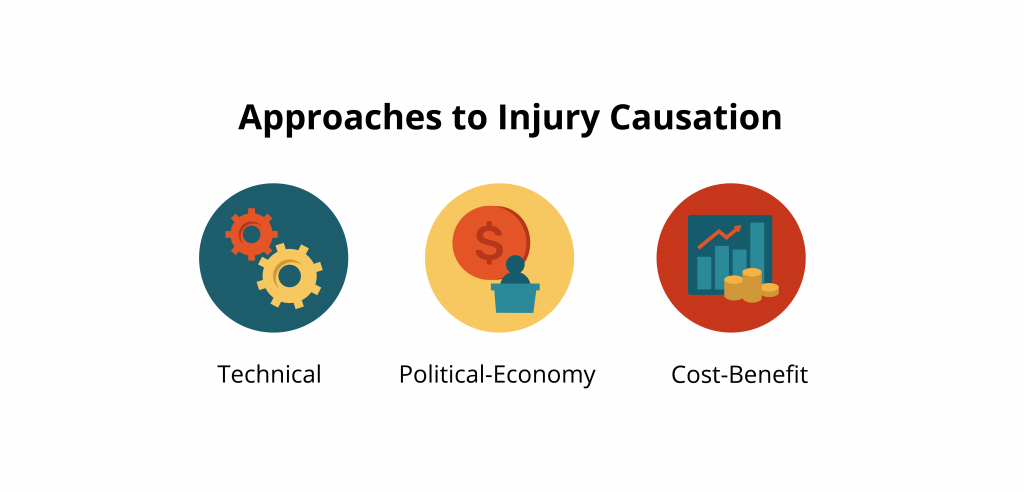1.2 Injury Causation
What causes workplace injuries? The obvious answer is workplace hazards. A workplace hazard is any source of potential injury or illness in a workplace. For example, a puddle of water on a floor creates a slipping hazard that could result in a worker sustaining injuries from a fall. Similarly, the presence of lead in the workplace could result in lead poisoning. Yet work-related hazards are not always so obvious. Sometimes the way in which work is organized causes health effects. For example, precarious employment—“paid work characterized by limited social benefits and statutory entitlements, job insecurity, low wages”—is associated with high risks of ill health.[1] Some studies suggest that jobs that demand a lot of effort but provide workers with little control over their work and little support can damage workers’ health via stress.[2]
In order to cause a workplace injury, the hazard acts upon the worker in some way. Physical hazards often entail a transfer of energy that results in an injury, such as a box falling off a shelf and striking a worker. Ergonomic hazards occur as a result of the interaction of work design and the human body. Chemical hazards are more complex. They may cause harm to human tissue in a variety of ways (e.g., some chemicals cause burns) or interfere with normal physiological functioning (e.g., some substances cause hallucinations). Biological hazards are organisms—such as bacteria, molds, funguses—or the products of organisms that harm human health. Psycho-social hazards are social environment and psychological factors that can affect human health and safety.
When considering the cause of an injury, it is useful to distinguish between proximate cause and root cause. Proximate cause is the event that is immediately responsible for the injury. Root cause refers to the ultimate or “real” cause of an injury. For example, if a worker falls down, the proximate cause may be that the worker lost her footing on a wet surface. Yet why was the surface wet? The root cause of the injury may have been an inadequately maintained hose that leaked. Considering both the proximate cause and root cause of an injury results in a better understanding of what caused the injury and, consequently, what can be done to prevent it.
The real world, of course, is messier than the proximate-and-root-cause model suggests. There is often a chain of causality that leads to an injury. In the example above, why was the hose not properly maintained? The root cause of that may well have been inadequate staffing levels. And what caused the inadequate staffing levels? Perhaps the employer was trying to minimize the cost of production. Why would the employer be trying to minimize costs? Perhaps because the employer feels pressure to maximize profitability.

When thinking about what causes injuries, it is also important to realize that there are both technical explanations and political-economy explanations. The technical approach to injury emphasizes the mechanism(s) of injury.
The political-economy approach to explaining workplace injury examines issues of power and financial gain to reveal why some hazards are remediated and others are not. This approach recognizes that employers and workers have differing interests in the workplace and therefore view workplace injuries differently.
Since perfect safety is unattainable, employers often adopt a cost-benefit approach to safety: safety should only be improved when it costs less to prevent the injury than the injury itself costs.[3] This isn’t to suggest that employers actively wish to see their workers injured or don’t take safety seriously. Rather, it highlights that employers and managers face structural pressures and that these pressures shape how they behave and, indeed, how they view issues like workplace safety.
These pressures are also felt in the public and non-profit sectors, where profit affects decisions in a more indirect fashion. While neither sector worries about profit per se, both have finite resources and face pressure to keep costs down. Non-governmental (non-profit) organizations rely heavily on funding from private donors and government grants, and these funders demand efficient use of their dollars.
- Vosko, L. (2006). Precarious employment: Towards an improved understanding of labour market insecurity. In L. Vosko (Ed.), Precarious employment: Understanding labour market insecurity in Canada. Montréal: McGill-Queen’s University Press, p. 4. ↵
- Lewchuk, W., Clarke, M., & de Wolfe, A. (2011). Working without commitments: The health effects of precarious employment. Montréal: McGill-Queen’s University Press. ↵
- Tucker, E. (1983–84). The determination of occupational health and safety standards in Ontario, 1860–1982. McGill Law Journal, 29, 260–311. ↵
Any source of potential injury or illness in a workplace, including objects, processes, contexts, people, or sets of circumstances.
Paid work characterized by limited social benefits and statutory entitlements, job insecurity, and low wages and associated with a high risk of ill health.
Workplace hazards potentially giving rise to injuries typically (but not always) caused by a transfer of energy that result in an injury.
Workplace hazards potentially giving rise to injuries caused by the interaction of work design and the human body.
Workplace hazards potentially giving rise to injuries caused by a chemical substance that harms human tissue or interferes with normal physiological functioning.
Workplace hazards potentially giving rise to injuries caused by organisms—such as bacteria, molds, funguses—or the products of organisms that harm human health.
Workplace hazards potentially giving rise to injuries caused by the social environment and psychological factors in the workplace.
The event that is immediately responsible for the injury.
The ultimate or “real” cause of an injury.
A way of looking at workplace injury that emphasizes the mechanism(s) of injury.
A way of looking at workplace injury that emphasizes issues of power and financial gain.
An approach to injury prevention that compares the cost of an injury with the cost of injury prevention.

